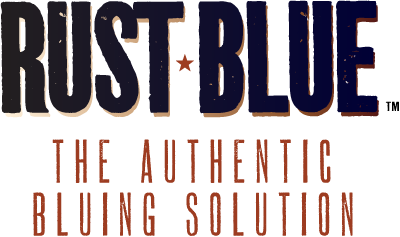Rust Bluing Woes
BlogIt is inevitable that you eventually run into some problems when rust bluing. Most can be traced to surface preparation and technique. The remainder fall into improper solution used and boiling/steaming issues.
Surface Preparation
I always sand/bead blast or use silicon carbide papers to polish the metal prior to bluing and never have any issues. Some folks like to use polishing wheels loaded with abrasive paste. These paste sticks contain waxes and oils. Hard buffing on the wheel can impregnate the metal with these long-chained hydrocarbons. Long chain hydrocarbons are bad for rust blues, or any other blues for that matter. They get down in the metal pores and prevent the blue from taking. Extensive soaking in mineral spirits, or a soak in 10% lye is needed to remove them. Oil/grease contamination is evident by patchy/splotchy/speckled bluing (light specks), or grey areas.
Technique
The biggest mistake folks make is to re-coat areas previously covered when applying the rust blue. Only apply the thinnest coat possible and barely connect wet edges. Over-coating can wipe away previously generated bluing. Excessive volume of solution can cause copper plating and runs, or crusty areas. If you miss a small area, use a Q-tip to cover it. Nickle steels used in Certain Winchester 94’s and late U.S. Springfields/M1917 Enfields require the use of American or Swiss Formulas. They may also need a special primer that I can provide free of charge with an order. Just let me know if you are bluing nickle steel alloy.
Boiling/Steaming Issues
Too low a temperature or insufficient boil/steam times can result in red colors, spotting, or streaking. Water contaminated with carbonates can result in an orange color when boiling. Minerals can give spotty bluing and color variations as well. I use steaming exclusively. Steam is absolutely pure with no contaminates. It is also far cheaper and faster to do vs boiling (see my Blog post on boiling vs Steaming). You can steam with tap water. If you boil, you need to use pure distilled water to assure results. When steaming, you must use a high volume of steam at full boil. Simmering steam will often result in bluing “runs” as the temperature is too low to cause flash evaporation of condensate. Don’t place the steel in the steam chamber until steam volume is at full flow.
Selecting a Formula
I have created a selection of formulas to cover the vast array of steels used in antique and collectible firearms over the last 200 or so years. Commercial manufacturers and government armories developed specific chemical formulas to efficiently and effectively blue the steel alloys in use at the time. Select a Rustblue Formula that matches the era and location of your firearms production. In general, all of these formulas were developed to blue carbon steel alloys with low nickle and carbon content, and for case-hardened steels. Modern 4140 steel will also blue well with all of the formulas. The fastest-acting are Swiss, German, and American Formulas. If you have a nickle-steel alloy arm (such as a late US Springfield/Enfield or Winchester 94) notify me with your order and I will ship you a primer at no charge.
Best regards,
Bob Veasey
President
www.rustblue.com

No comments yet.